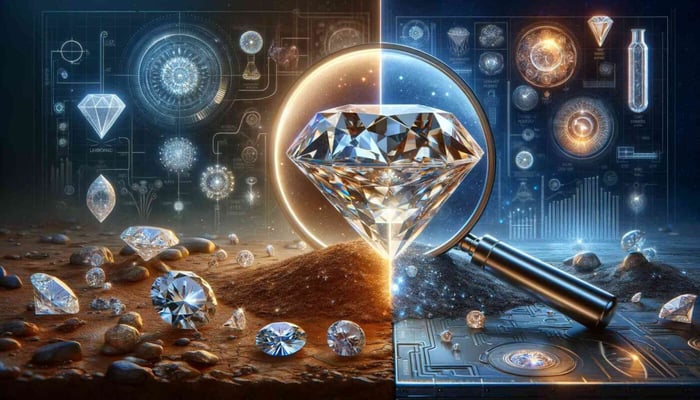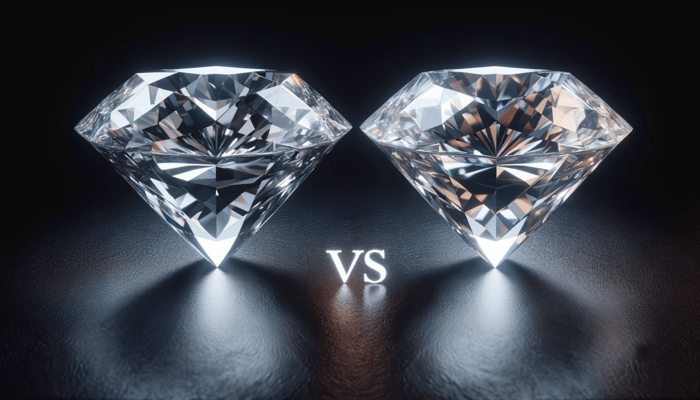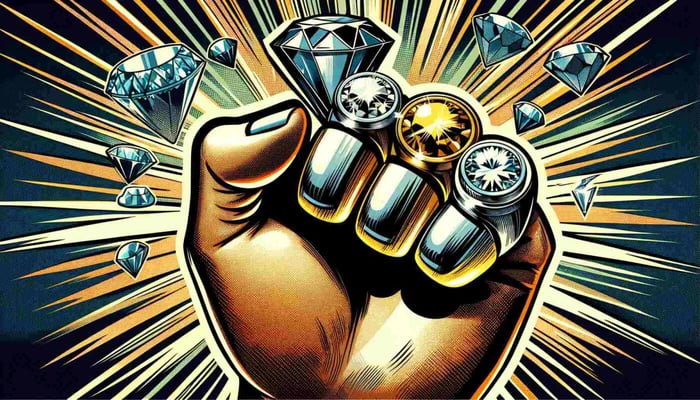Discover key insights into natural diamonds vs. lab-grown diamonds to make an informed decision about your next diamond jewellery purchase.
Understanding Natural and Lab-Grown Diamonds
When it comes to diamonds, most people envision luxurious gemstones formed deep within the Earth's crust over billions of years. This holds true for natural diamonds, but there's also a rising star: lab-grown diamonds. Here, we delve into the differences and similarities between natural diamonds vs. lab-grown diamonds.
The Formation Process
One of the key distinctions between natural and lab-grown diamonds is the time it takes for them to form. Natural diamonds are created under extreme pressure and heat deep within the Earth's mantle over billions of years. This process involves carbon atoms being arranged in a crystal lattice structure, which gives diamonds their unique properties.
On the other hand, lab-grown diamonds are created in a much shorter time, typically in a matter of weeks. In a laboratory setting, scientists simulate the same conditions that occur naturally to create diamonds. By introducing a carbon source and applying high pressure and temperature, they can speed up the formation process and produce diamonds with similar properties to natural ones.
£965.00
Embrace the beauty of the Ella Lab Diamond Solitaire Engagement Ring, handcrafted in the UK. This exquisite ring features a breathtaking 1.00ct G/VS round-cut lab-grown diamond set in platinum. The ring is IGI certified, UK hallmarked, and comes with a… read moreElla Lab Diamond Solitaire Engagement Ring 1.00ct G/VS Platinum
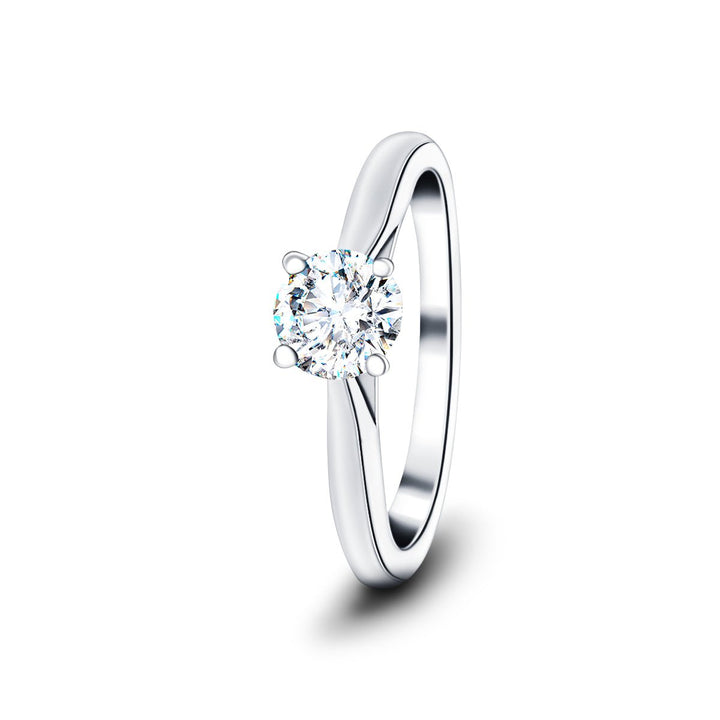
£1,826.00
Visual and Chemical Similarities
Visually, it is nearly impossible to distinguish between natural and lab-grown diamonds without the use of advanced testing equipment. Both types of diamonds exhibit the same physical characteristics and optical properties. They have the same brilliance, sparkle, and clarity, making it difficult for the naked eye to tell them apart.
Furthermore, natural and lab-grown diamonds have the same chemical composition. They both consist of carbon atoms arranged in a crystal lattice structure. This means that, chemically speaking, lab-grown diamonds are identical to their natural counterparts.
The Perception of Lab-Grown Diamonds
Despite their similarities, lab-grown diamonds are often considered "fake" diamonds by some. This misconception stems from the belief that only natural diamonds are valuable and authentic. However, lab-grown diamonds are just as real as natural diamonds. Reputable gemological institutes certify and grade them, and they share the same physical and chemical properties.
In recent years, there has been a growing demand for lab-grown diamonds due to their ethical and environmental advantages. Unlike natural diamonds, which are often mined in ecologically sensitive areas, lab-grown diamonds have a minimal impact on the environment. Additionally, the diamond industry has made significant progress in developing advanced technologies to produce larger and higher-quality lab-grown diamonds.
£760.00
The Nancy Lab Diamond Halo Pear Engagement Ring in 9k Yellow Gold is a work of art designed to capture the essence of your love. This stunning ring features beautiful 0.85 carats of lab-grown G/VS grade diamonds. A halo of… read moreNancy Lab Diamond Halo Pear Engagement Ring 0.85ct G/VS in 9k Yellow Gold
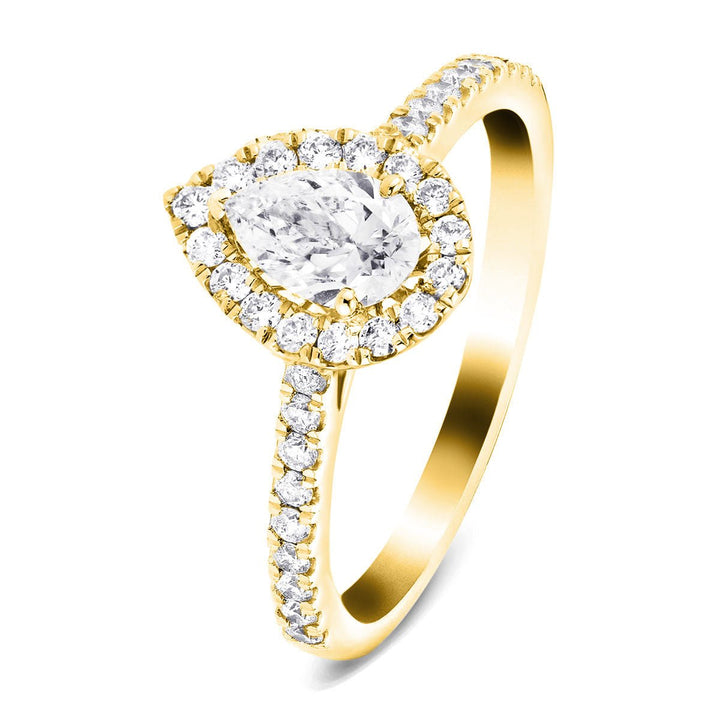
£1,346.00
Natural and lab-grown diamonds may have different formation processes, but they share many similarities. Both types of diamonds look the same and have the same chemical composition. Lab-grown diamonds are not "fake" diamonds; they are made of carbon, just like natural diamonds. The increasing demand for lab-grown diamonds highlights a shift towards ethical and environmentally friendly alternatives in the diamond industry. Whether you choose a natural or lab-grown diamond, both options offer their own unique advantages and beauty.

Factors to Consider When Choosing Between Natural Diamonds vs. Lab-Grown Diamonds
When selecting a diamond, various factors need to be weighed, especially when comparing natural diamonds vs. lab-grown diamonds. Deciding between a natural and a lab-grown diamond is crucial, hinging on your personal preferences and necessitating detailed research.
The Decision to Buy Natural or Lab-Grown Diamonds
The decision to buy a natural or lab-grown diamond is a personal one. Resale value, cost, and ethical considerations are just a few of the variables that affect it.
Lab-grown diamonds, also known as lab diamonds or synthetic diamonds, are created in a laboratory using advanced technological processes that simulate the natural formation of diamonds. They are chemically and optically identical to natural diamonds, but they are created in a controlled environment.
One of the main advantages of lab-grown diamonds is their lower cost. On average, lab-grown diamonds cost about 40% less than a natural diamond of the same quality. This makes them a more affordable option for those on a budget.
However, it's important to note that natural diamonds have historically retained their value over time. Natural diamonds have a long-standing reputation for being a store of value and are often seen as an investment. On the other hand, lab-grown diamonds have little to no resell value. If you're considering purchasing a diamond as an investment, a natural diamond may be a better option.
N.B., investment diamonds are usually larger than most people use in their jewellery and being able to sell a natural diamond ring for the same price as its retail price may take many years, meaning that the investment aspect of the choice between mined and lab-grown diamonds does not apply to most jewellery buyers!
Personal Priorities
Choosing between a natural or lab-grown diamond is a decision that ultimately depends on your personal priorities and values. If you place a high value on ethical considerations and want to ensure that your diamond has been sourced responsibly, a lab-grown diamond is probably the better choice. Diamonds grown in laboratories are conflict-free and do not have an impact on the environment due to diamond mining.
On the other hand, if you value the prestige and symbolism associated with natural diamonds and are looking for a diamond that may hold its value over time, a natural diamond may be more suitable for you.
Remember, the decision to buy a natural or lab-grown diamond should be based on careful consideration of your personal priorities and research into the options available. Whether you choose a natural or lab-grown diamond, it's important to select a diamond that speaks to your individual style and values.
Diamond Quality Matters: Cut, Material, and Setting
While the visual similarity of natural and lab-grown diamonds is important, it's essential to consider the quality of the diamond before making a purchase. The quality of the cut, material, and setting can greatly impact the overall appearance and value of the diamond.
Firstly, the cut of the diamond determines how well it reflects light and sparkles. Whether it's a natural or lab-grown diamond, a high-quality cut will enhance its beauty and brilliance. Be sure to choose a diamond with a well-proportioned cut to ensure maximum sparkle.
Secondly, the material of the diamond plays a crucial role in its quality. Natural diamonds are composed of carbon atoms arranged in a crystal lattice structure, while lab-grown diamonds have the same chemical composition. However, lab-grown diamonds are created in a controlled environment, allowing for greater control over their quality and purity.
Lastly, the setting of the diamond can significantly impact its overall presentation. The right setting can enhance the diamond's beauty, while a poor setting may detract from its brilliance. Consider the type of metal, prong style, and overall design when selecting the setting for your diamond.
The Importance of Sustainability
When it comes to diamonds, sustainability is a concern that applies to both natural and lab-grown options. Natural diamonds are sourced through mining, which has significant environmental and social impacts. Mining can cause habitat destruction, water pollution, and even human rights abuses in some cases.
On the other hand, lab-grown diamonds offer a more sustainable and ethical alternative. They are created in a laboratory setting using advanced technology, significantly reducing the need for mining. Lab-grown diamonds have a smaller carbon footprint and do not contribute to the exploitation of natural resources.
However, it's important to note that not all lab-grown diamonds are created equal in terms of sustainability. Look for diamonds that are certified as being sourced from responsible manufacturers who follow environmentally friendly practices.
Choosing between natural and lab-grown diamonds is a personal decision that depends on your values and priorities. The live comparison video clearly demonstrates the visual similarity between the two types of diamonds, ensuring that lab-grown diamonds can provide the same beauty and sparkle as their natural counterparts.
When making a purchase, remember to consider the quality of the cut, material, and setting to ensure you get the best value for your money. And don't forget about sustainability—both natural and lab-grown diamonds have their own environmental and ethical implications. By opting for a lab-grown diamond, you can make a more sustainable choice without compromising on style and elegance.
Making the Right Choice: Natural Diamonds vs. Lab-grown Diamonds
When it comes to purchasing a diamond ring, especially an engagement ring, making the right choice is crucial. There are several factors to consider, such as budget, size, and quality.
£1,230.00
Experience the beauty of true love with the stunning Molly Three Stone Lab Diamond Engagement Ring, handcrafted in the UK with the finest materials. This breathtaking ring features a total of 1.50 carats of D/VVS IGI-certified lab-grown diamonds set in… read moreMolly Three Stone Lab Diamond Engagement Ring 1.50ct D/VVS in 9k White Gold

£2,351.00
Discuss with your Partner
Before making any final decisions, it is important to discuss the purchase with the partner who will be wearing the diamond. Their input and preferences should be taken into consideration, as they will be the one wearing it for years to come. This ensures that both parties are on the same page and have a clear understanding of what they want.
Quality of the Setting
Regardless of whether you choose a natural or lab-grown diamond, the quality of the setting is equally important. The setting not only holds the diamond in place, but also enhances its overall appearance.
Be sure to choose a setting that complements the diamond and fits your partner's style. Whether it's a classic solitaire or a more intricate design, the setting should be well-crafted and durable. Additionally, the metal used for the setting, such as platinum or gold, should be of high quality to ensure its longevity.
Remember, the setting can significantly impact the overall look and feel of the diamond ring. It is worth investing in a well-made setting that will showcase the beauty of the diamond and provide long-lasting satisfaction.
In conclusion, making the right choice when purchasing a diamond involves considering various factors. By discussing the purchase with your partner, exploring options like lab-grown diamonds, and ensuring the quality of the setting, you can make a decision that is both budget-friendly and satisfying in the long run.
High-Quality Craftsmanship With After Diamonds
When it comes to finding the perfect ring, After Diamonds stands out for its exceptional craftsmanship. Each piece of jewellery is meticulously crafted to create a stunning piece that will last a lifetime. Whether you're looking for a classic design or a more unique style, After Diamonds has options to suit almost any taste.
£828.00
Experience the timeless beauty of love with the Milly Two Stone Lab Diamond Engagement Ring, designed in 18k white gold. With a total weight of 1.00 carats of G/VS-graded lab-created round diamonds, this ring is IGI certified and UK hallmarked.… read moreMilly Two Stone Lab Diamond Engagement Ring 1.00ct G/VS in 18k White Gold

£1,481.00
Visit After Diamonds for Expert Advice and Beautiful Designs
Choosing the perfect ring can be a complex decision, especially when considering natural diamonds vs. lab-grown diamonds. The experts at After Diamonds specialize in both and are here to help. With their deep understanding of the differences and benefits of each type, they offer valuable guidance to ensure you make an informed choice.
At After Diamonds, you'll find a wide selection of beautifully designed rings. Whether you're looking for a traditional design or something more modern, their collection has something for everyone. Every piece is crafted with the utmost care and attention to detail, resulting in exceptional quality.
Choose from a wide range of designs that complement your style, including solitaire, halo, and vintage-inspired designs. Visit After Diamonds for expert advice, beautiful designs, and an enjoyable shopping experience.


